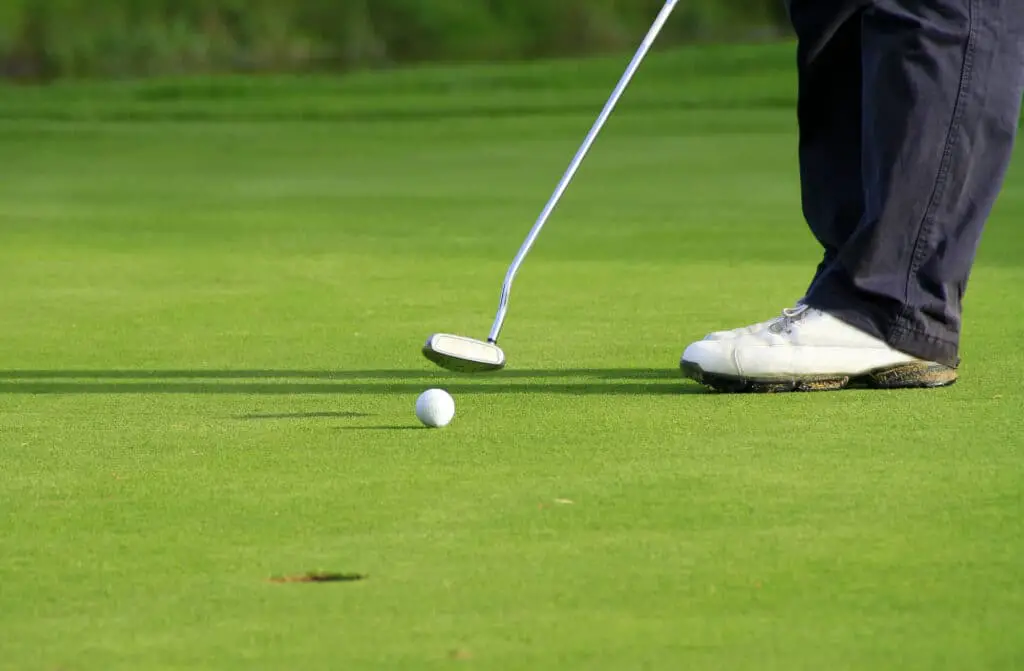Last Updated on November 7, 2023
Golfers know that putting is the key to success on the green. With the right guidance, you can quickly become a putting pro and start to reap the rewards of your hard work on the green. From proper grip and stance all the way through your follow-through – this guide will help you hone your putt in golf skills so you can achieve greatness out on the course. Putt in golf isn’t just about having a good swing. There are many other aspects of technique involved too. To ensure our putts are as successful as can be, let’s explore the various techniques to consider.
Table of Contents:
- Grip and Stance
- Swing Path
- Follow Through
- Practice Makes Perfect
- FAQs in Relation to How to Putt in Golf
- Conclusion
Grip and Stance
Gripping the Putter
It’s all in the wrist. A proper grip on your putter is essential to achieving a consistent stroke and getting the ball where you want it to go. The most common grip for putting is called the “reverse overlap,” which involves placing your left hand slightly lower than your right, overlapping two fingers of each hand around the handle of the club. By gripping the club with two fingers of each hand overlapping, you will be able to regulate the force used for each putt.
Good Stance
Position your feet at a comfortable width apart and hold your arms at a right angle to the body. To ensure accuracy, make sure that when looking down at address (the start position) that both eyes are directly over top of the ball – this will help keep everything in line as you swing back and through. If there’s any slope to either side of the green, adjust accordingly by standing closer or further away from the target depending on the direction of the slope – think, ‘go uphill with less loft; go downhill with more loft’.

Alignment
When setting up for a putt, always check alignment before taking aim at the hole – if one foot is out of line, then chances are so too will be the rest of the body, including shoulders & head, leading to poor contact & off-line path. Use an alignment aid such as a golf club shaft across toes or even a yardstick laid flat on the ground parallel with the intended starting line & point towards the target; once feet/shoulders/head aligned correctly, then take aim & execute the stroke confidently knowing correct setup has been achieved.
For those who find it difficult to keep their hands in a consistent plane throughout the stroke, attempting an arcing motion as opposed to a straight back and through technique can be beneficial. This curving action allows the golfer to maintain their wrists in proper alignment while avoiding any deceleration issues that may arise from over-accelerating putts due to ‘flipping’ at impact.
No matter what your golfing ability is, honing the fundamentals such as stance, grip and posture through regular practice is essential for achieving peak performance on the course. These basics form the foundation upon which a successful putting game can be built. Therefore, don’t just rely on theory but also take time hitting some balls onto the practice green regularly until you are confident enough that you have developed the skills needed to perform well under pressure come tournament day.
Swing Path
When it comes to putting, your swing path is key. To hit a successful putt, you need to make sure that your clubhead follows the same path throughout the entire stroke. The ideal swing path for a putt should be an arc shape with the ball in the middle of this arc. This means that as you take your backswing and bring your club up, it should follow an upward curved line until it reaches its peak height before coming down on a slightly downward curved line towards impact.
The type of putt you are attempting will affect how wide or narrow this arc needs to be – if you’re hitting a long-distance putt, then the arc should be wider than if you were making a short-distance one. Visualise an imaginary circumference surrounding the ball when you set up your putt. This will give you a clue as to how much wiggle room there is and which swing trajectory would be most advantageous for that particular shot.
Your backswing should also have minimal wrist action. Instead, use your arms and shoulders to generate power while keeping everything else still during your stroke. It’s important not to rush through any part of the motion either. Ensure that each movement is controlled so that all parts can move together in harmony with each other without breaking form or tempo throughout your entire shot routine from start to finish.
Follow Through
Following through on your putt is an essential part of any golf game, and it’s one that many people struggle with. It’s important to ensure that you are following through properly in order to maximise accuracy and consistency when putting.
The most common mistake made by amateur golfers is not finishing their swing or “short-arming” the ball. This causes the ball to go off course due to a lack of power behind the stroke. To prevent this from happening, make sure you have extended your arms fully before releasing the club head at impact.

Another key element of a successful follow-through is having a good posture throughout your entire swing path. Keep your back straight, and knees slightly bent as you complete the motion, which will help create more consistent contact with the ball each time you putt. Additionally, try not to move too quickly during this phase. Take it slow and steady for maximum control over where the ball goes after impact.
Finally, focus on keeping your eyes up throughout both phases of putting: setup and follow through. Keeping track of where you want the ball to go will allow for better aim while also helping maintain balance throughout both parts of putting—this can be especially helpful if there are slopes or hills present in front of where you’re aiming.
Practice Makes Perfect
It’s no secret that practice makes perfect when it comes to golf. If you want to improve your game, there’s no substitute for spending time on the course and hitting those balls. How much practice is required to make progress? And what should you focus on during your practice sessions?
First off, consistency is key. For optimal results, try to divide your practice into shorter segments spread out over the course of days or weeks. This will help ensure that each session is focused and effective.
When it comes to putting specifically, aim for a steady rhythm with each stroke – this will help keep your hands in sync with the putter head as well as help develop muscle memory so that you can replicate consistent strokes more easily over time. Try setting yourself targets of sinking 10 consecutive putts from 3 feet away before moving back further – once you’ve achieved this goal consistently, then move back 5 feet and repeat until eventually working up towards 20-30 footers (or longer). This ‘laddering’ technique helps break down long-distance shots into manageable chunks, which are easier to master over time – think of it like climbing stairs rather than trying to leap straight onto the top floor.

Another great way of improving accuracy is by using alignment sticks while practising on the green: set them up parallel with one another around 2-3 feet apart and then practise rolling putts between them without touching either stick – if done correctly, this will encourage better ball control since any misalignment between the clubface and ball path will be immediately obvious. Finally, why not challenge yourself by playing a few rounds against friends or family members – competing against others can often bring out our best performances due to increased adrenaline levels.
FAQs in Relation to How to Putt in Golf
How do you putt in golf for beginners?
Putting is an essential skill in golf and requires precision and practice to master. It involves using a flat-faced club, typically called the putter, to hit the ball with minimal backspin on it. To begin putting correctly, start by standing comfortably behind the ball while keeping your eyes focused directly over it. Place your hands slightly ahead of the ball so that you can feel where they are in relation to its position throughout your stroke. When ready, keep your arms straight as you swing them back towards yourself before swinging through impact with a slight acceleration for added distance control and accuracy. Make sure to follow through after contact has been made for maximum effectiveness.
What are the basics of putting in golf?
It involves striking the ball with a putter, which has a flat face and low loft angle to keep the ball rolling along the ground rather than flying through the air. The goal of putting is to get the ball into or close to the hole in as few strokes as possible by judging speed, distance, break (the direction of curvature on sloped greens), green conditions, wind speed/direction and other factors. To do this effectively, it’s important for players to practice regularly and develop good technique, including proper grip pressure on their club handle; an even tempo throughout their stroke; maintaining balance while keeping eyes focused over or behind the ball at address; using correct alignment relative to the target line; choosing appropriate clubs based on length of shot required etc. With enough practice, one can become proficient at putting – leading ultimately towards lower scores.
What is the 2 putt rule?
The two-putt rule is a golfing regulation that states players must complete each hole in no more than two strokes on the green. This means they must sink their first putt or chip within two shots of the ball being placed. Otherwise, they incur a penalty stroke. The rule applies to all levels of play, from beginner to professional and helps ensure fair competition by ensuring everyone has an equal chance at success when playing golf. It also prevents players from taking advantage of any breaks in terrain or other variables that could give them an unfair edge over their opponents.
Conclusion
Putting in golf can be a tricky skill to master, but with the right grip and stance, swing path, follow-through and practice, you will soon find yourself sinking more putts than ever before. Putting is an important part of any golfer’s game, so take your time to ensure that each putt in golf is taken seriously – only then will you reap the rewards.



